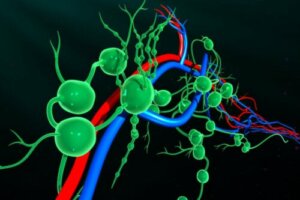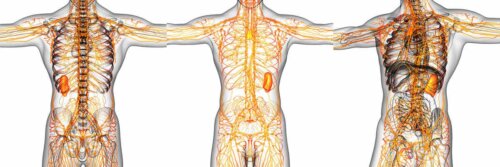The Link Between the Lymphatic and Circulatory Systems


Written and verified by the doctor Leonardo Biolatto
The lymphatic and circulatory systems are two fundamental body structures. Both are basically an extensive network of vessels that run throughout the body. People tend to think of them as independent from one another, but this isn’t so.
In fact, the lymphatic and circulatory systems are interconnected. The main function of this connection is to control the amount of fluid present in the body. It also allows them to help prevent infection and disease.
Their workings are complex, but you’ll know what they’re about at the end of this article. Here, we’ll explain blood circulation, the lymphatic system, and how these complement each other.
What’s the circulatory system?
The circulatory system is responsible for transporting blood to tissues and organs throughout the body. It’s made up of the blood vessels and the heart. Keep in mind the heart is the pump that propels the blood through the vessels.
This is essential, as the blood transports the oxygen needed for the cells of each tissue to survive. In addition, other substances (nutrients, hormones, and gases) travel through the blood, as this article in Visuals Online explains.
The circulatory system also contributes to the elimination of waste such as carbon dioxide or certain proteins. Almost 90 % of all the pumped blood returns to the heart.
The tissues filter the other 10%, thanks to the capillaries. This filtered fluid contains proteins, wastes, bacteria, and other microorganisms and separates from most of the blood cells.
What is the lymphatic system?
The lymphatic system is a network of vessels and tissues, just like the circulatory one. In this case, the transported fluid is known as lymph. Furthermore, the lymphatic vessels are tubular structures that run throughout the body. Also, there are between 500 and 600 lymph nodes distributed throughout the body.
The main function of the lymphatic system is to cleanse the lymph of abnormal cells or infectious microorganisms. In other words, it plays a leading role in the immune system. The organs involved are the tonsils, thymus, and spleen.
All these organs are responsible for producing cells of the immune system, such as T-lymphocytes and B-lymphocytes. These are specializations responsible for fighting pathogens in a specific way. That is they travel with the lymph and concentrate to a greater extent in the lymph nodes, which act as a filter for potentially aggressive particles.

You may be interested in How to Cleanse Your Lymphatic System: 5 plant-based solutions
How is the lymphatic system related to the circulatory system?
Some people think the lymphatic and circulatory systems are independent of each other. However, the blood vessels aren’t impervious and small amounts of liquid can leak out.
According to an article in Breast Cancer, this liquid accumulates in the spaces between the cells and tissues. Then, the vessels of the lymphatic system collect it and form the lymph.
The lymphatic system isn’t closed though. That is, it can release and collect fluids. Furthermore, unlike the circulatory system, it doesn’t have a pump that propels the fluid, as does the heart. Thus, lymph moves slowly.
The movement of the lymph is due to the pressure exerted by the muscles on the lymphatic vessels. This is why body movement, such as walking, stimulates it.
Lymph circuit
The smaller lymphatic vessels are also called capillaries and the fluid collects through them. Lymph leaves the lymphatic capillaries for the collecting vessels, which are larger and have valves.
The valves allow the lymph to circulate in one direction only. Then, this fluid passes through the lymph nodes which, as mentioned above, are responsible for filtering out any waste, toxins, and microorganisms.
They contain immune system cells so they can deter infections and although nodes are distributed throughout the body, they’re more concentrated in certain areas such as the armpits, groin, and neck.
The lymph leaves the nodes to go into the lymph ducts, and then these ducts drain it into a large vein. Thus, the fluid returns to the circulatory system.
Infections in the lymphatic or circulatory system
The lymphatic system has the function of purifying the body fluids to prevent infections. Blood is usually sterile because the circulatory system is closed.
However, there could be an infection in the blood through wounds, catheters, or needles. When this happens, immune cells, antibodies, and other agents attack the pathogens.
Nevertheless, these microorganisms spread rapidly when the body fails to eliminate them. Bacteremia happens when bacteria enter the blood and viremia in the case of viruses. In turn, we say there’s septicemia if the infectious agents begin to reproduce and spread.
Infections in the lymphatic system
There’s usually no microbiota in the lymphatic system as immune cells usually eliminate any pathogens early on.
However, there’re highly virulent pathogens that can overcome such defenses. In that case, infection occurs in the lymphatic system and it leads to a large inflammatory response. We say there’s lymphangitis when this response occurs in the lymphatic vessels.
In turn, an inflamed lymph node means a person has lymphadenitis. This is frequent in people with a compromised immune system.

One can stimulate the lymphatic and circulatory systems
The lymphatic system is fundamental and because it’s related to the circulatory system it needs to maintain a constant amount of fluid in the body. In addition, they work together to protect the body from possible infections.
Unlike the circulatory system, however, the lymphatic system has no pump to stimulate circulation. Thus, accumulation is possible.
One of the ways to stimulate the lymphatic system is to exercise — going for a walk, jogging, swimming, or strength training all help. In addition, massages are other good measures.
Manual lymphatic drainage improves lymph circulation and consists of applying gentle pressure to different areas of the body, following the path of the vessels. It reduces the appearance of edema and stimulates this system.
All cited sources were thoroughly reviewed by our team to ensure their quality, reliability, currency, and validity. The bibliography of this article was considered reliable and of academic or scientific accuracy.
- El sistema linfático. (n.d.). Retrieved May 6, 2021, from https://www.breastcancer.org/es/tratamiento/linfedema/como/sistema_linfatico
- Sistema Circulatorio y Sistema Linfático (Circulatory System And Lymphatic System): Image Details – NCI Visuals Online. (n.d.). Retrieved May 6, 2021, from https://visualsonline.cancer.gov/details.cfm?imageid=12215
- Vinyes, Frederic. La linfa y su drenaje manual. RBA Libros, 2016.
This text is provided for informational purposes only and does not replace consultation with a professional. If in doubt, consult your specialist.








